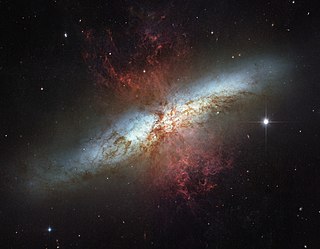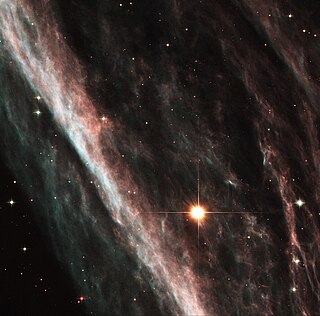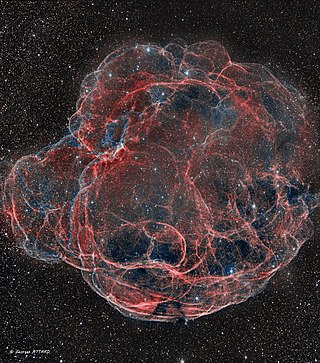
A supernova remnant (SNR) is the structure resulting from the explosion of a star in a supernova. The supernova remnant is bounded by an expanding shock wave, and consists of ejected material expanding from the explosion, and the interstellar material it sweeps up and shocks along the way.

The Crab Nebula is a supernova remnant and pulsar wind nebula in the constellation of Taurus. The common name comes from a drawing of the object produced by William Parsons, 3rd Earl of Rosse, in 1842 or 1843 using a 36-inch (91 cm) telescope that somewhat resembled a crab with arms. The nebula was discovered by English astronomer John Bevis in 1731. It corresponds with a bright supernova recorded by Chinese astronomers in 1054 as a guest star. The nebula was the first astronomical object identified that corresponds with a historically-observed supernova explosion.

Messier 82 (also known as NGC 3034, Cigar Galaxy or M82) is a starburst galaxy approximately 12 million light-years away in the constellation Ursa Major. It is the second-largest member of the M81 Group, with the D25 isophotal diameter of 12.52 kiloparsecs (40,800 light-years). It is about five times more luminous than the Milky Way and its central region is about one hundred times more luminous. The starburst activity is thought to have been triggered by interaction with neighboring galaxy M81. As one of the closest starburst galaxies to Earth, M82 is the prototypical example of this galaxy type. SN 2014J, a type Ia supernova, was discovered in the galaxy on 21 January 2014. In 2014, in studying M82, scientists discovered the brightest pulsar yet known, designated M82 X-2.

The Tarantula Nebula is a large H II region in the Large Magellanic Cloud (LMC), forming its south-east corner.

3C 58 or 3C58 is a pulsar and supernova remnant within the Milky Way. The object is listed as No. 58 in the Third Cambridge Catalogue of Radio Sources.

SS 433 is a microquasar or eclipsing X-ray binary system, consisting of a stellar-mass black hole accreting matter from an A-type companion star. SS 433 is the first discovered microquasar. It is at the centre of the supernova remnant W50.

First observed between August 4 and August 6, 1181, Chinese and Japanese astronomers recorded the supernova now known as SN 1181 in eight separate texts. One of only five supernovae in the Milky Way confidently identified in pre-telescopic records, it appeared in the constellation Cassiopeia and was visible and motionless against the fixed stars for 185 days. F. R. Stephenson first recognized that the 1181 AD "guest star" must be a supernova, because such a bright transient that lasts for 185 days and does not move in the sky can only be a galactic supernova.

A nova remnant is made up of the material either left behind by a sudden explosive fusion eruption by classical novae, or from multiple ejections by recurrent novae. Over their short lifetimes, nova shells show expansion velocities of around 1000 km/s, whose faint nebulosities are usually illuminated by their progenitor stars via light echos as observed with the spherical shell of Nova Persei 1901 or the energies remaining in the expanding bubbles like T Pyxidis.

SN 1572, or B Cassiopeiae, was a supernova of Type Ia in the constellation Cassiopeia, one of eight supernovae visible to the naked eye in historical records. It appeared in early November 1572 and was independently discovered by many individuals.

W49B is a nebula in Westerhout 49 (W49). The nebula is a supernova remnant, probably from a type Ib or Ic supernova that occurred around 1,000 years ago. It may have produced a gamma-ray burst and is thought to have left a black hole remnant.

The Cygnus Loop is a large supernova remnant (SNR) in the constellation Cygnus, an emission nebula measuring nearly 3° across. Some arcs of the loop, known collectively as the Veil Nebula or Cirrus Nebula, emit in the visible electromagnetic range. Radio, infrared, and X-ray images reveal the complete loop.

NGC 2736 is a small part of the Vela Supernova Remnant, located near the Vela Pulsar in the constellation Vela. The nebula's linear appearance triggered its popular name. It resides about 815 light-years away from the Solar System. It is thought to be formed from part of the shock wave of the larger Vela Supernova Remnant. The Pencil Nebula is moving at roughly 644,000 kilometers per hour.

The Vela supernova remnant is a supernova remnant in the southern constellation Vela. Its source Type II supernova exploded approximately 11,000 years ago. The association of the Vela supernova remnant with the Vela pulsar, made by astronomers at the University of Sydney in 1968, was direct observational evidence that supernovae form neutron stars.

The Gum Nebula is an emission nebula that extends across 36° in the southern constellations Vela and Puppis. It lies approximately 450 parsecs from the Earth. Hard to distinguish, it was widely believed to be the greatly expanded remains of a supernova that took place about a million years ago. More recent research suggests it may be an evolved H II region. It contains the 11,000-year-old Vela Supernova Remnant, along with the Vela Pulsar.

The Veil Nebula is a cloud of heated and ionized gas and dust in the constellation Cygnus.

IC 443 is a galactic supernova remnant (SNR) in the constellation Gemini. On the plane of the sky, it is located near the star Eta Geminorum. Its distance is roughly 5,000 light years from Earth.

The known history of supernova observation goes back to 1006 AD. All earlier proposals for supernova observations are speculations with many alternatives.

G292.0+01.8 is a supernova remnant located in the constellation Centaurus. It first gained notice as a strong radio source, and eventually deep images revealed a hot optical nebula at the location. It lies about 15,000 light years away.

Simeis 147, also known as the Spaghetti Nebula, SNR G180.0-01.7 or Sharpless 2-240, is a supernova remnant (SNR) in the Milky Way, straddling the border between the constellations Auriga and Taurus. It was discovered in 1952 at the Crimean Astrophysical Observatory by Grigory Shajn and his team using a Schmidt camera and a narrowband filter close to the Hydrogen Alpha transmission line. It is difficult to observe due to its extremely low brightness. This discovery was part of a survey conducted between 1945 and 1955, most likely using captured German equipment, as the observatory was practically destroyed during WWII. The Schmidt camera had a field of view of 175'. Many previously unknown hydrogen nebula were discovered this way, as they are not readily visible in regular photographs.

















